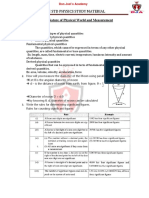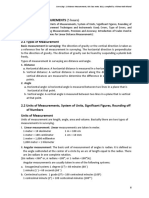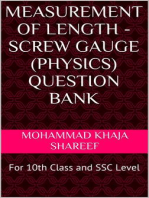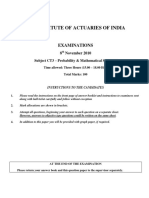0 ratings0% found this document useful (0 votes)
70 views1st Lessonl
1st Lessonl
Uploaded by
MAURICEThe document discusses physical quantities and measurement. It defines fundamental and derived physical quantities. It describes methods to measure larger distances like the diameter of the Moon using parallax and the triangulation and radar methods. It explains the rules for determining significant figures and defines precision and accuracy with an example. It discusses limitations of dimensional analysis and types of errors like random, systematic and gross errors. It also explains the concept of propagation of errors in the addition and multiplication of measured quantities.
Copyright:
© All Rights Reserved
Available Formats
Download as DOCX, PDF, TXT or read online from Scribd
1st Lessonl
1st Lessonl
Uploaded by
MAURICE0 ratings0% found this document useful (0 votes)
70 views4 pagesThe document discusses physical quantities and measurement. It defines fundamental and derived physical quantities. It describes methods to measure larger distances like the diameter of the Moon using parallax and the triangulation and radar methods. It explains the rules for determining significant figures and defines precision and accuracy with an example. It discusses limitations of dimensional analysis and types of errors like random, systematic and gross errors. It also explains the concept of propagation of errors in the addition and multiplication of measured quantities.
Original Title
1st Lessonl.docx
Copyright
© © All Rights Reserved
Available Formats
DOCX, PDF, TXT or read online from Scribd
Share this document
Did you find this document useful?
Is this content inappropriate?
The document discusses physical quantities and measurement. It defines fundamental and derived physical quantities. It describes methods to measure larger distances like the diameter of the Moon using parallax and the triangulation and radar methods. It explains the rules for determining significant figures and defines precision and accuracy with an example. It discusses limitations of dimensional analysis and types of errors like random, systematic and gross errors. It also explains the concept of propagation of errors in the addition and multiplication of measured quantities.
Copyright:
© All Rights Reserved
Available Formats
Download as DOCX, PDF, TXT or read online from Scribd
Download as docx, pdf, or txt
0 ratings0% found this document useful (0 votes)
70 views4 pages1st Lessonl
1st Lessonl
Uploaded by
MAURICEThe document discusses physical quantities and measurement. It defines fundamental and derived physical quantities. It describes methods to measure larger distances like the diameter of the Moon using parallax and the triangulation and radar methods. It explains the rules for determining significant figures and defines precision and accuracy with an example. It discusses limitations of dimensional analysis and types of errors like random, systematic and gross errors. It also explains the concept of propagation of errors in the addition and multiplication of measured quantities.
Copyright:
© All Rights Reserved
Available Formats
Download as DOCX, PDF, TXT or read online from Scribd
Download as docx, pdf, or txt
You are on page 1of 4
UNIT –
01 NATURE OF PHYSICAL WORLD AND MEASUREMENT
TWO MARKS AND THREE MARKS:
1. Briefly explain the types of physical quantities.
1. Physical quantities are classified into two types. They are fundamental and derived
quantities.
2. Fundamental or base quantities are quantities which cannot be expressed in terms of
any other physical quantities. These are length, mass, time, electric current,
temperature, luminous intensity and amount of substance.
3. Quantities that can be expressed in terms of fundamental quantities are called
derived quantities. For example, area, volume, velocity, acceleration, forces.
2. How will you measure the diameter of the Moon using parallax method?
i) C is the centre of the Earth. A and B are two diametrically opposite places on the
surface of the Earth. From A and B, the parallaxes θ1 and θ2 respectively of Moon M
with respect to some distant star are determined with the help
of an astronomical
telescope. Thus, the total parallax of the Moon subtended on
Earth
If θ is measured in radians, then
Knowing the values of AB and θ,
We can calculate the distance MC of Moon from the Earth.
3. Write the rules for determining significant figures.
i) All non-zero digits are significant. Ex.1342 has four significant figures
ii) All zeros between two non zero digits are significant.
Ex. 2008 has four significant figures
iii) All zeros to the right of a non-zero digit but to the left of a decimal point are significant
Ex. 30700. has five significant figures
iv) The number without a decimal point, the terminal or trailing zero(s) are not significant
Ex. 30700 has three significant figures
All zeros are significant if they come from a measurement
Ex. 30700 m has five significant figures
v) If the number is less than 1, the zero (s) on the right of the decimal point but to left of
the first non zero digit are not significant.
Ex. 0.00345 has three significant figures
vi) All zeros to the right of a decimal point and to the right of non-zero digit are
significant. Ex. 40.00 has four significant figures and
0.030400 has five significant
figures
vii) The number of significant figures does not depend on the system of units used
Ex.1.53 cm, 0.0153 m, 0.0000153 km, all
have three significant figures
M.Sudharshan M.Sc. B.Ed MS STUDY CIRCLE PH: 9566631115 1
UNIT –
4. What are the limitations of dimensional analysis?
1. This method gives no information about the dimensionless constants in the
formula like 1, 2, ……..π,e, etc.
2. This method cannot decide whether the given quantity is a vector or a scalar.
3. This method is not suitable to derive relations involving trigonometric, exponential
and logarithmic functions.
4. It cannot be applied to an equation involving more than three physical quantities.
5. It can only check on whether a physical relation is dimensionally correct but not the
1
correctness of the relation. For example using dimensional analysis, s = ut + at2 is
3
1
dimensionally correct whereas the correct relation is s = ut + at2
2
5. Define precision and accuracy. Explain with one example.
Precision: The closeness of two or more measurements to each other.
Accuracy: The closeness of a measure value to the actual value of the object being
measured is called accuracy.
Ex.: The true value of a certain length is near 5.678 cm. In one experiment, using a
measuring instrument of resolution 0.1 cm, the measured value is found to be 5.5 cm. In
another experiment using a measuring instrument of greater resolution, say 0.01 cm,
and the length is found to be 5.38 cm. We find that the first measurement is more
accurate as it is closer to the true value, but it has lesser precision. On the contrary, the
second measurement is less accurate, but it is more precise.
1. i) Explain the use of screw gauge and vernier caliper in measuring smaller
distances.
ii) Write a note on triangulation method and radar method to measure larger
distances.
i) Measurement of small distances:
Screw gauge: The screw gauge is an instrument used for measuring accurately the
dimensions of objects up to a maximum of about 50 mm. The principle of the instrument
is the magnification of linear motion using the circular motion of a screw. The least count
of the screw gauge is 0.01 mm
Vernier caliper: A vernier caliper is a versatile instrument for measuring the dimensions
of an object namely diameter of a hole, or a depth of a hole. The least count of the
vernier caliper is 0.1 mm
ii) Measurement of large distances
For measuring larger distances such as the height of a tree, distance of the Moon or a
planet from the Earth, some special methods are adopted. Triangulation method,
parallax method and radar method are used to determine very large distances.
iii)Triangulation method for the height of an accessible object
Let AB = h is the height of the tree or tower to be measured. Let C be the point of
observation at distance x from B. Place a range finder at C and measure the angle of
elevation, ∠ACB = θ as shown in Figure.
From right angled triangle ABC,
𝐴𝐵 ℎ
tan θ = =
𝐵𝐶 𝑥
(or)
Height h = x tan θ
Knowing the distance x, the height h can be
determined.
M.Sudharshan M.Sc. B.Ed MS STUDY CIRCLE PH: 9566631115 2
UNIT –
RADAR method
The word RADAR stands for radio detection and ranging. Radar can be used to
measure accurately the distance of a nearby planet such as Mars. In this method, radio
waves are sent from transmitters which, after reflection from the planet, are detected by
the receiver.
By measuring, the time interval (t) between the instants the radio waves are sent and
received, the distance of the planet can be determined as
Distance (d) = Speed of radio waves × time taken
where v is the speed of the radio wave.
As the time taken (t) is for the distance covered during the forward and backward path of
the radio waves, it is divided by 2 to get the actual distance of the object. This method
can also be used to determine the height, at which an aeroplane flies from the ground.
2. Explain in detail the various types of errors.
Random error, systematic error and gross error are the three possible errors
Systematic errors:
Systematic errors are reproducible inaccuracies that are consistently in the same
direction.
Instrumental errors
1) When an instrument is not calibrated properly at the time of manufacture, these errors
can be corrected by choosing the instrument carefully.
Imperfections in experimental technique or procedure
2) These errors arise due to the limitations in the experimental arrangement. To
overcome these, necessary correction has to be applied.
Personal errors
3) These errors are due to individuals performing the experiment, may be due to
incorrect initial setting up of the experiment or carelessness of the individual making the
observation due to improper precautions
Errors due to external causes
4) The change in the external conditions during an experiment can cause error in
measurement. For example, changes in temperature, humidity, or pressure during
measurements may affect the result of the measurement
5) Least count error
Least count is the smallest value that can be measured by the measuring instrument,
and the error due to this measurement is least count error.
ii) Random errors
6) Random errors may arise due to random and unpredictable variations in experimental
conditions like pressure, temperature, voltage supply etc.
7) Errors may also be due to personal errors by the observer who performs the
experiment. Random errors are sometimes called “chance error”
8) It can be minimized by repeating the observations a large number of measurements
are made and then the arithmetic mean is taken.
Gross Error
9) The error caused due to the shear carelessness of an observer is called gross error.
These errors can be minimized only when an observer is careful and mentally alert.
M.Sudharshan M.Sc. B.Ed MS STUDY CIRCLE PH: 9566631115 3
UNIT –
3. What do you mean by propagation of errors? Explain the propagation of
errors in addition and multiplication.
A number of measured quantities may be involved in the final calculation of an
experiment. Different types of instruments might have been used for taking readings.
Then we may have to look at the errors in measuring various quantities, collectively.
The error in the final result depends on
1) The errors in the individual measurements
2) On the nature of mathematical operations performed to get the final result. So we
should know the rules to combine the errors. The various possibilities of the
propagation or combination of errors in different mathematical operations are
discussed below
(i) Error in the sum of two quantities
Let ΔA and ΔB be the absolute errors in the two quantities A and B respectively.
Then,
Measured value of A = A ± ΔA
Measured value of B = B ± ΔB
Consider the sum, Z = A + B
The error ΔZ in Z is then given by
Z ± ΔZ = (A ± ΔA) + (B ± ΔB)
= (A + B) ± (ΔA + ΔB)
= Z ± (ΔA + ΔB)
(or) ΔZ = ΔA + ΔB
The maximum possible error in the sum of two quantities is equal to the sum of the
absolute errors in the individual quantities.
(ii) Error in the difference of two quantities
Let ΔA and ΔB be the absolute errors in the two quantities, A and B, respectively. Then,
Measured value of A = A ± ΔA
Measured value of B = B ± ΔB
Consider the difference, Z = A – B
The error ΔZ in Z is then given by
Z ± ΔZ = (A ± ΔA) + (B ± ΔB)
= (A - B) ± (ΔA ∓ ΔB)
= Z ± (ΔA ∓ ΔB)
(or) ΔZ = ΔA + ΔB
The maximum error in difference of two quantities is equal to the sum of the absolute
errors in the individual quantities.
4. Write short notes on the following.
a) Unit
b) Rounding - off
c) Dimensionless quantities
5. Explain the principle of homogeneity of dimensions. What are its uses? Give
example.
M.Sudharshan M.Sc. B.Ed MS STUDY CIRCLE PH: 9566631115 4
You might also like
- Looking For Petronilla EssayDocument2 pagesLooking For Petronilla EssayGAIA ZIZZINo ratings yet
- Leadership Style & Talent Management Strategies OF Glaxo SmithklineDocument51 pagesLeadership Style & Talent Management Strategies OF Glaxo SmithklineTanzil HossainNo ratings yet
- Xi STD Physics Study Material: Unit 1 Nature of Physical World and MeasurementDocument10 pagesXi STD Physics Study Material: Unit 1 Nature of Physical World and MeasurementDON JOEL'S ACADEMY Online CoachingNo ratings yet
- 1 Nature of Physical World and Measurement PDFDocument8 pages1 Nature of Physical World and Measurement PDFKanish kirthick grade 8No ratings yet
- XI STD. PHYSICS MINIMUM STUDY MATERIAL MR 2020 - 2021-Watermarked-5Document73 pagesXI STD. PHYSICS MINIMUM STUDY MATERIAL MR 2020 - 2021-Watermarked-5karevisarjNo ratings yet
- Nature of Physical World and MeasurementDocument19 pagesNature of Physical World and MeasurementkarevisarjNo ratings yet
- 11th Physics Volume 1 and 2 Study Material English Medium PDF DownloadDocument63 pages11th Physics Volume 1 and 2 Study Material English Medium PDF Downloadmahaphotos491No ratings yet
- Analysis of Experimental DataDocument9 pagesAnalysis of Experimental DataSaid SaayfanNo ratings yet
- Activity 1 (Lab Report) - Alban, Ronel D.Document4 pagesActivity 1 (Lab Report) - Alban, Ronel D.Ronel AlbanNo ratings yet
- STD Xi Physics Complete NotesDocument144 pagesSTD Xi Physics Complete Notesanupbag970No ratings yet
- 74-11th Physics - Book Back Questions - English Medium PDF DownloadDocument63 pages74-11th Physics - Book Back Questions - English Medium PDF DownloadjohnsonNo ratings yet
- Nature of Physical World and Measurement: Multiplechoice QuestionsDocument51 pagesNature of Physical World and Measurement: Multiplechoice Questionsbsai2749No ratings yet
- Technological University of The Philippines College of Engineering Mechanical Engineering DepartmentDocument13 pagesTechnological University of The Philippines College of Engineering Mechanical Engineering DepartmentJeshua LloreraNo ratings yet
- Physics Notes S2Document121 pagesPhysics Notes S2nanastase41No ratings yet
- Report of PracticumDocument27 pagesReport of PracticumIrdayani HamidNo ratings yet
- Measurement UncertaintiesDocument49 pagesMeasurement UncertaintiesJoshua CanonicatoNo ratings yet
- erreurs-er-incertitudesDocument6 pageserreurs-er-incertitudesaaronlungutsgNo ratings yet
- Modul 1Document7 pagesModul 1Thinagaran GunasegaranNo ratings yet
- Lecture 2 - Principles of Surveying, Part 2Document15 pagesLecture 2 - Principles of Surveying, Part 2Receb AgaNo ratings yet
- 2 Distance MeasurementsDocument12 pages2 Distance MeasurementsSuson DhitalNo ratings yet
- Units and MeasurementsDocument62 pagesUnits and MeasurementsMemoy MishraNo ratings yet
- Chapter 1Document84 pagesChapter 1Isabelle LohNo ratings yet
- Experiment Worksheet 1Document7 pagesExperiment Worksheet 1mekhloufb27No ratings yet
- M0_ENG_T_R.docx pdfDocument9 pagesM0_ENG_T_R.docx pdfUgurNo ratings yet
- Activity 1 (Activity Guide)Document3 pagesActivity 1 (Activity Guide)Ronel AlbanNo ratings yet
- Notes - Unit & MeasurementDocument7 pagesNotes - Unit & Measurementmanishmuneshwar07No ratings yet
- Documento Sem TítuloDocument6 pagesDocumento Sem Títulomariaisabelcordeiro000No ratings yet
- Basic Masurment and UncertainlyDocument29 pagesBasic Masurment and UncertainlyHelny LydarisboNo ratings yet
- Lab Act 2 PhysicsDocument5 pagesLab Act 2 PhysicsraphaelNo ratings yet
- PHYS 1401 General Physics I Experiment 1 Measurement and Units I. ObjectiveDocument5 pagesPHYS 1401 General Physics I Experiment 1 Measurement and Units I. Objectivejaymart villartaNo ratings yet
- Physics 003 Units and Physical QuantitiesDocument4 pagesPhysics 003 Units and Physical QuantitiesAngel Lou LiwagonNo ratings yet
- s2 Merged PDFDocument117 pagess2 Merged PDFAsutosh PandaNo ratings yet
- Ece 2306 Notes Vi Jan2014Document14 pagesEce 2306 Notes Vi Jan2014TinaNo ratings yet
- PHY107 Spring24Document56 pagesPHY107 Spring24Mehedi Hasan Shobuj Mehedi Hasan ShobujNo ratings yet
- Computation and MeasurementDocument12 pagesComputation and MeasurementhachanNo ratings yet
- PHY107 Lab ManualsDocument56 pagesPHY107 Lab ManualsSam BlackwoodNo ratings yet
- chapter oneDocument43 pageschapter oneAbdulaziz sheikh AbukarNo ratings yet
- Chap2 - Measurement Errors F Li L2 PDFDocument5 pagesChap2 - Measurement Errors F Li L2 PDFTRESIA LYNN SEPANTONNo ratings yet
- Phy107l1 6Document37 pagesPhy107l1 6Tihum KabirNo ratings yet
- Physics V2Document65 pagesPhysics V2Thea VelascoNo ratings yet
- Experiment 1 - Mass, Volume and GraphingDocument10 pagesExperiment 1 - Mass, Volume and GraphingThina Cruz Torres0% (1)
- Physics Introduction 1Document28 pagesPhysics Introduction 1Ndumiso NkabindeNo ratings yet
- Measurement Lab Report _241211_091940 (1)Document39 pagesMeasurement Lab Report _241211_091940 (1)hanakb77No ratings yet
- Significant Figures and MeasurementsDocument8 pagesSignificant Figures and MeasurementsBilal HazratNo ratings yet
- Measurement and ErrorsDocument7 pagesMeasurement and ErrorsBerke NarNo ratings yet
- 11.1 Nature of physical worldDocument6 pages11.1 Nature of physical worldjanavkarthick1No ratings yet
- Units and Measurement-NotesDocument10 pagesUnits and Measurement-Notescypher.kksNo ratings yet
- Measurement and Uncertainty Lecture Notes For 11th Grade Ib StudentsDocument29 pagesMeasurement and Uncertainty Lecture Notes For 11th Grade Ib StudentsEge Özerol100% (1)
- PHYS112 LabManualDocument86 pagesPHYS112 LabManualefekistanNo ratings yet
- 15 Systematic and Random ErrorsDocument12 pages15 Systematic and Random ErrorsSamata LuintelNo ratings yet
- Unit 11.1 MEASUDocument13 pagesUnit 11.1 MEASUStephanie A TomeropNo ratings yet
- +1 Phy (Em) Study Material Vol 1 (2023 - 24)Document28 pages+1 Phy (Em) Study Material Vol 1 (2023 - 24)skumaransathya2006No ratings yet
- Chapter 1 - Introduction To Survey AdjustmentDocument20 pagesChapter 1 - Introduction To Survey AdjustmentMohd Syakir57% (7)
- 114A 118A Manual Chapters 1 and 2 Spring 2014Document20 pages114A 118A Manual Chapters 1 and 2 Spring 2014abbitibariisoNo ratings yet
- Unit 0 - Observations, Measurements and Calculations: 1.3 Thinking Like A Scientist - The Scientific MethodDocument4 pagesUnit 0 - Observations, Measurements and Calculations: 1.3 Thinking Like A Scientist - The Scientific MethoddanielmahsaNo ratings yet
- Ste Adv Phys q1 Las 1 9Document46 pagesSte Adv Phys q1 Las 1 9KonichiwichiNo ratings yet
- General Physics 1: Intro Ductio NDocument44 pagesGeneral Physics 1: Intro Ductio Npalitpa moreNo ratings yet
- 10th Grade Physics - Unit 1Document25 pages10th Grade Physics - Unit 1Alice ScarletNo ratings yet
- Physics Week 3Document9 pagesPhysics Week 364sxbj8hmwNo ratings yet
- Lect 2Document31 pagesLect 2Shubham MauryaNo ratings yet
- Measurement of Length - Screw Gauge (Physics) Question BankFrom EverandMeasurement of Length - Screw Gauge (Physics) Question BankNo ratings yet
- Learn Statistics Fast: A Simplified Detailed Version for StudentsFrom EverandLearn Statistics Fast: A Simplified Detailed Version for StudentsNo ratings yet
- APPLIED MOTIVATIONAL PRACTICES (Sanyo Sunny)Document30 pagesAPPLIED MOTIVATIONAL PRACTICES (Sanyo Sunny)Rahul RajeshNo ratings yet
- The French Revolution Chapter 1 Reference NotesDocument19 pagesThe French Revolution Chapter 1 Reference NotesUtkarshNo ratings yet
- This Master'S Thesis Titled "Effects of Adjunct Displays To SpeakingDocument4 pagesThis Master'S Thesis Titled "Effects of Adjunct Displays To SpeakingRi El100% (1)
- The Role of Branding in Consumer Decision MakingDocument103 pagesThe Role of Branding in Consumer Decision MakingBhavik WaghelaNo ratings yet
- 4 Layers of Strength - Elliot HulseDocument34 pages4 Layers of Strength - Elliot HulseCatalin Popa78% (9)
- Case Digest Conflict of LawsDocument23 pagesCase Digest Conflict of LawsJilbert CabajarNo ratings yet
- CESC - Lesson 2 Different Perspectives of CommunityDocument21 pagesCESC - Lesson 2 Different Perspectives of CommunityLeah Joy Valeriano-Quiños100% (2)
- Bhupendra Jogi.Document6 pagesBhupendra Jogi.aditya.patil06198No ratings yet
- WITNESSDocument13 pagesWITNESSnitish heyNo ratings yet
- 2.3. PPT FPL Akademik WK-2Document39 pages2.3. PPT FPL Akademik WK-2Marcus Abracosa CaraigNo ratings yet
- The Chapter Al-Waqi'ah (56) : Most Rational & Strictly Academic Re-TranslationsDocument18 pagesThe Chapter Al-Waqi'ah (56) : Most Rational & Strictly Academic Re-Translationsi360.pkNo ratings yet
- The Effect of Stabilization and Relaxation Method With Rehabilitation Exercises in Reducing Knee Joint Pain For PlayersDocument1 pageThe Effect of Stabilization and Relaxation Method With Rehabilitation Exercises in Reducing Knee Joint Pain For PlayersHas SimNo ratings yet
- Chinese: CoinsDocument515 pagesChinese: CoinsDigital Library Numis (DLN)No ratings yet
- Models of Castes Left Hand and Right HandDocument18 pagesModels of Castes Left Hand and Right HandSathyamoorthy VenkateshNo ratings yet
- (WWW - Entrance-Exam - Net) - IAI-CT3 - Probability and Mathematical Statistics Sample Paper 12Document7 pages(WWW - Entrance-Exam - Net) - IAI-CT3 - Probability and Mathematical Statistics Sample Paper 12Sachin BarthwalNo ratings yet
- Breaking Personal and Generational BondagesDocument40 pagesBreaking Personal and Generational Bondagesapcwo50% (2)
- Olé Lashkara BrochureDocument84 pagesOlé Lashkara BrochureAustin NadarNo ratings yet
- Lalitha Sahasranamam - Hindupedia, The Hindu EncyclopediaDocument26 pagesLalitha Sahasranamam - Hindupedia, The Hindu EncyclopediaPuvenes ManiamNo ratings yet
- Chapter 12 IssumboshiDocument2 pagesChapter 12 IssumboshiWahyu Melanie PratiwiNo ratings yet
- Ayurvedic Medical Astrology - Dr. Srividya SubramanianDocument9 pagesAyurvedic Medical Astrology - Dr. Srividya SubramanianSunilkumar Dubey100% (1)
- Resume (MD Faisal Morshed)Document2 pagesResume (MD Faisal Morshed)Faisal SunnyNo ratings yet
- Annotated Bibliography - Makinley BrownDocument8 pagesAnnotated Bibliography - Makinley Brownapi-588974946No ratings yet
- Eagleton Event of Literature ReviewDocument5 pagesEagleton Event of Literature Reviewc5pgcqzv100% (1)
- Creating Industrial Network With PROFINET Communication For Education PurposesDocument7 pagesCreating Industrial Network With PROFINET Communication For Education PurposesHưng NguyễnNo ratings yet
- 6.1a What Is Observation 2Document88 pages6.1a What Is Observation 2wcmf66ywq8No ratings yet
- Sample Paper Syllabus 2016-17: ClassDocument2 pagesSample Paper Syllabus 2016-17: ClassSrinivasNo ratings yet
- Language and Nation: Israel Yelovich Sofía Lacoste 3 °ADocument28 pagesLanguage and Nation: Israel Yelovich Sofía Lacoste 3 °ASofia1505No ratings yet
























































































